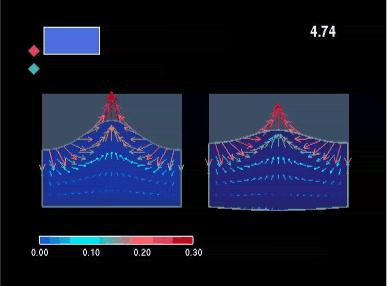
|
In marine engineering, sloshing flows, i.e. resonant fluid motion in confined domains, play a significant role in many practical circumstances. For example, ship response to incoming waves can excite violent motions of transported liquids (crude oil, liquified gas, etc.) which, in turn, implies structural loads and modifies the dynamic behaviour of the entire vessel. Therefore, accurate prediction of sloshing loads is of main concern during the design stage of ship tanks. In most of the applications, the dynamic interaction between the structural vibrations and the flow field is neglected, i.e. fluid loads are determined by studying liquid sloshing in rigid tanks. However, the accuracy of this simplified analysis is questionable when dealing with lighter structures or high-strength structural steels. This latter case is of growing importance in current design practice, and the modeling of fluid-structure interaction is needed to understand the various hydroelastic phenomena and to assess the safety of the system.
On this ground, fundamental aspects of the dynamics of two-dimensional sloshing flows in a deformable container have been analyzed. To the purpose, the capabilities of two different coupling strategies (a strong coupling and a loose coupling interaction model) have been exploited. Both methods consist in a partition of the nonlinear time-dependent fluid-solid coupled problem. Partitioning have been considered either through an explicit time stepping procedure, or by reformulating the problem as a sequence of subproblems on fluid and solid domains, respectively, that exchange data on the common interface. In this case, a semi-implicit predictor-corrector time advancing scheme has been adopted.
Both the coupling strategies are applied to solve the incompressible Navier-Stokes equations for the fluid and a linear elastic continuum model for the solid domain. Nonlinearities due to the free surface and to the nonlinear fluid-solid coupling are accounted for through an Arbritary Lagrangian Eulerian formulation of the relevant equations.
The applicability of the resulting algorithms is demonstrated through various examples. In particular, we have studied the response of flexible two dimensional rectangular containers to free and forced vibrations. For some configurations, strong hydroelastic effects have been evidenced.
Issues related to the stability and the accuracy of the coupling strategies are under analysis and will also be discussed to identify a stable, accurate and efficient algorithm to solve this interesting hydroelatic problem.
Research project funded by the INSEAN 1997-1999 research program Area 3, Objective 3.2.5.2, Project officer: Maurizio Landrini, INSEAN